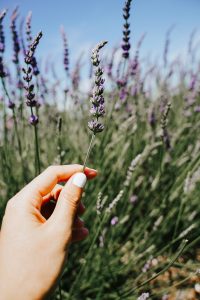Essential oils are made of 100% all natural ingredients.

Extracted from different parts of a plant, such as flowers, herbs, or roots these oils are pure extractions that are obtained through the process of steam distillation or solve extractions and are not cut with a type of carrier oil. There are 100% pure oils are, meaning they have not been processed, diluted or manipulated in any way with solvents or other additives. Essential oils are difficult to reproduce synthetically since they can be made up of 500 different naturally occurring chemicals.
Also, depending on the season, climate, or growing conditions of a plant, the chemical components of a particular essential oil may vary. Therefore, it is difficult for craft makers to keep their finished products consistent.
There are two broad types of fragrance oils:
- Synthetic Fragrance Oils
- Natural Fragrance Oils
Synthetic fragrance oils are artificially created from chemical compounds that do not exist in nature.

These are the types of fragrances to avoid when reading a label, especially if you have skin sensitivities. Many times, they are composed of petroleum by-products, making them much cheaper but versatile. Many of the cheaper commercial scented products are created with synthetic fragrances because they are able to retain their aroma for longer periods of time.
Natural Fragrance oils are also made in a lab but are created by isolating natural aromatic components from a complex scent. There is still debate as to whether natural fragrance oils can be considered truly natural. While they are derived from a natural source, they are still created by human science. Our view is where possible, we will stick to essential oils but there are cases where an argument could be made for natural fragrance oils.
Which have more health benefits?
Essential oils have many uses in aromatherapy to help ease muscle pain, skin problems, and other bodily afflictions. The reason essential oils are so valued is its use in skin and hair softening, skin moisturizing, rash, and eczema relief, and it’s helpfulness on stress and migraine relief. Essential oils can also be taken internally while fragrance oils cannot. Many people apply essential oils directly to skin or use it during their baths. Others may apply it through an olfactory system, such as a humidifier.
Most fragrance oils don’t provide the same health benefits as essential oils, as they’re designed purely for the purpose of mimicking a scent. Nature is complex and essential oils are made of more than just scent components, which is why they are so difficult to recreate. When we isolate only the natural aromatic components from a plant, we miss out on the potential benefits the plant could offer. However, fragrance oils do enhance the aroma of many cosmetics and perfume products.
It is important to note that every individual is different and there are cases where individuals may be still allergic to components from an essential oil. Just because it is all natural does not mean it works for everyone.
What impacts the quality of essential oils?
Essential oils have recently become more popular due to the “all natural” trend. this has led to the rise of various essential oil producers. It’s important to know that the quality of essential oils can vary widely. The quality of a batch of essential oils can be impacted by:
- How the plants are grown: The use of pesticides and other chemicals, the variability in altitude, soil conditions and rainfall, and the difficulty of differentiating plant species and varieties can all have a negative impact on the ultimate quality of the oil
- Processing: Not all oils on the market are suitable for clinical use. Today, you can buy essential oils everywhere- from Amazon, to discount stores, to grocery stores, and more. If the price of a bottle of essential oil is “too good to be true”, it could be a sign of the oils being diluted or adulterated.
- Packaging and handling: Chemical degradation can occur with exposure to heat, light, or oxygen. Take for example, essential oils from citrus fruits, which are especially prone to oxidation. Oxygen exposure can quickly alter the chemistry of those essential oils.
- Storage: Essential oils should be stored in tightly closed, darkened glass containers in a cool place to ensure lasting quality The usual shelf life is 2-3 years after opening.4

